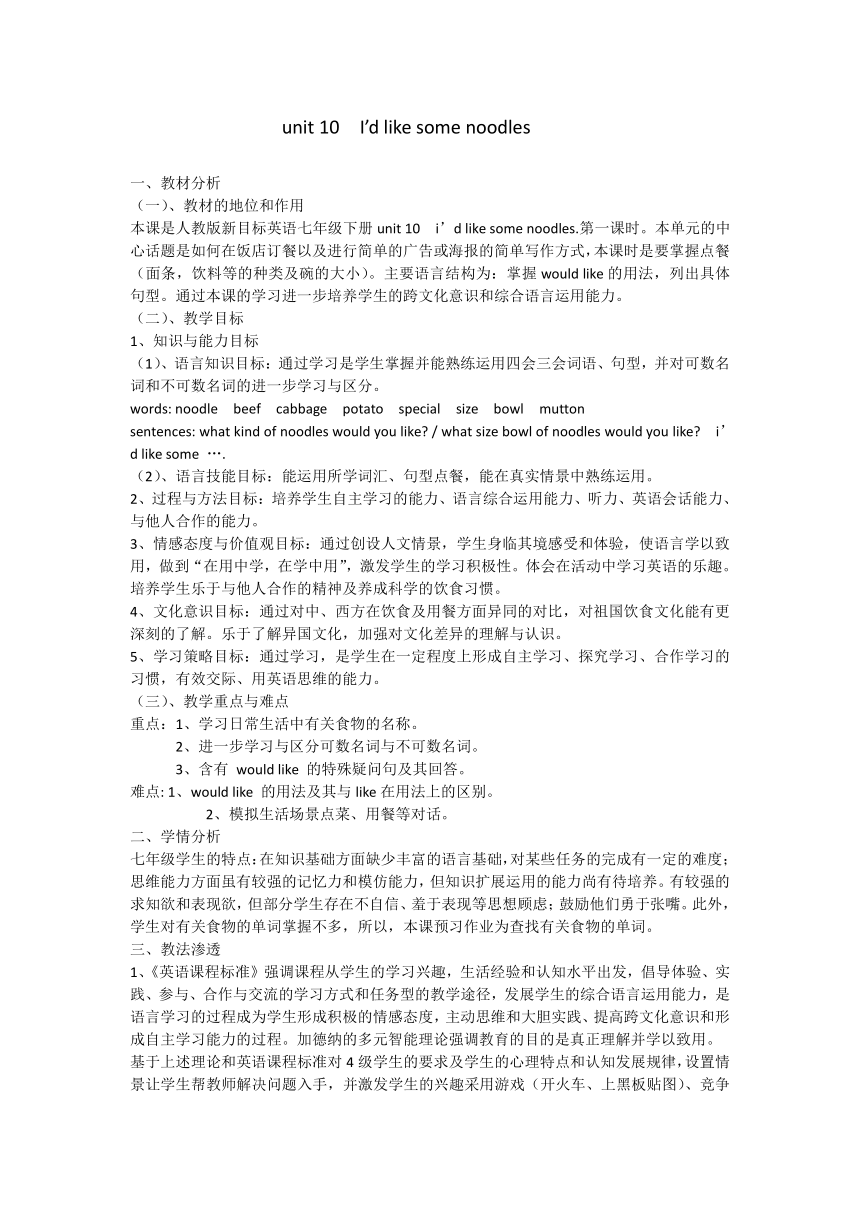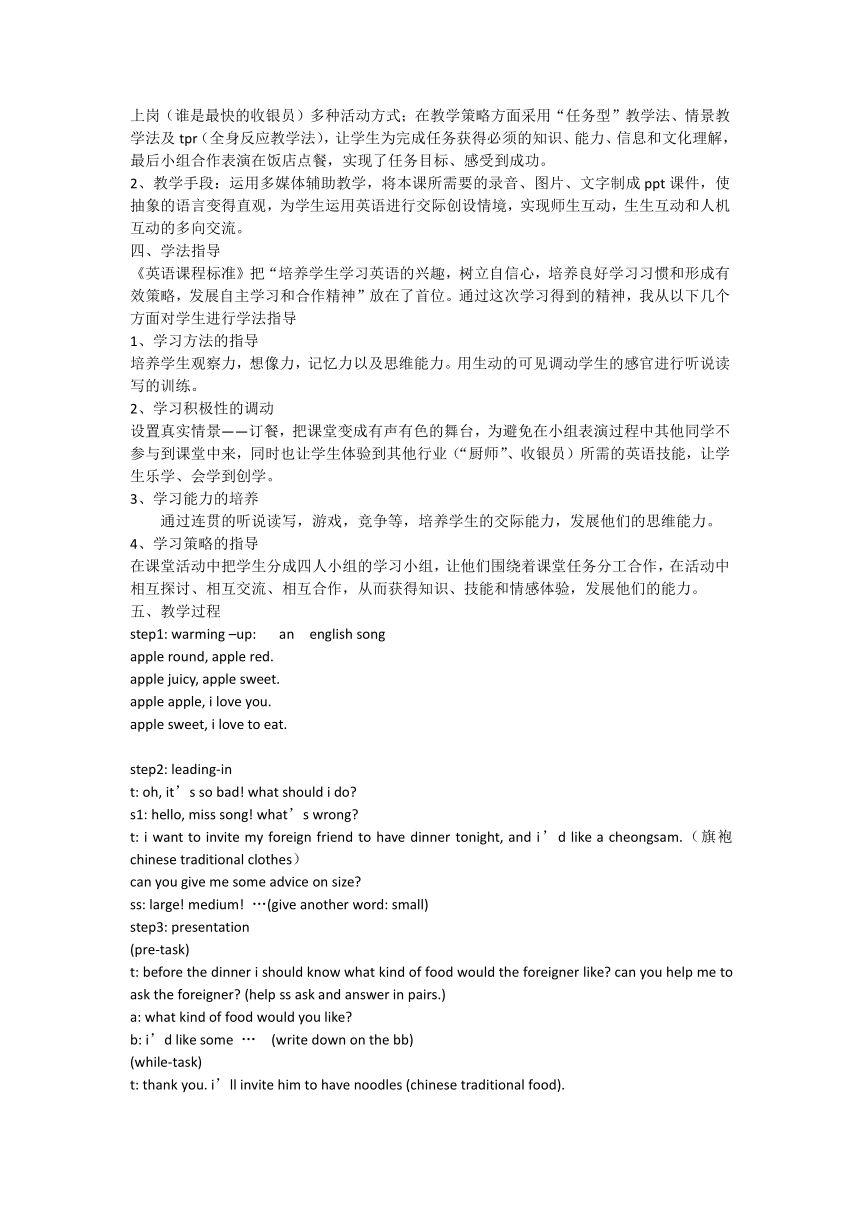人教版七年级下册 Unit10 I'd like some noodles. SectionA 1a-2c 教案
文档属性
| 名称 | 人教版七年级下册 Unit10 I'd like some noodles. SectionA 1a-2c 教案 |  | |
| 格式 | doc | ||
| 文件大小 | 39.5KB | ||
| 资源类型 | 教案 | ||
| 版本资源 | 人教新目标(Go for it)版 | ||
| 科目 | 英语 | ||
| 更新时间 | 2022-12-18 23:27:08 | ||
图片预览


文档简介
unit 10 I’d like some noodles
一、教材分析
(一)、教材的地位和作用
本课是人教版新目标英语七年级下册unit 10 i’d like some noodles.第一课时。本单元的中心话题是如何在饭店订餐以及进行简单的广告或海报的简单写作方式,本课时是要掌握点餐(面条,饮料等的种类及碗的大小)。主要语言结构为:掌握would like的用法,列出具体句型。通过本课的学习进一步培养学生的跨文化意识和综合语言运用能力。
(二)、教学目标
1、知识与能力目标
(1)、语言知识目标:通过学习是学生掌握并能熟练运用四会三会词语、句型,并对可数名词和不可数名词的进一步学习与区分。
words: noodle beef cabbage potato special size bowl mutton
sentences: what kind of noodles would you like / what size bowl of noodles would you like i’d like some ….
(2)、语言技能目标:能运用所学词汇、句型点餐,能在真实情景中熟练运用。
2、过程与方法目标:培养学生自主学习的能力、语言综合运用能力、听力、英语会话能力、与他人合作的能力。
3、情感态度与价值观目标:通过创设人文情景,学生身临其境感受和体验,使语言学以致用,做到“在用中学,在学中用”,激发学生的学习积极性。体会在活动中学习英语的乐趣。培养学生乐于与他人合作的精神及养成科学的饮食习惯。
4、文化意识目标:通过对中、西方在饮食及用餐方面异同的对比,对祖国饮食文化能有更深刻的了解。乐于了解异国文化,加强对文化差异的理解与认识。
5、学习策略目标:通过学习,是学生在一定程度上形成自主学习、探究学习、合作学习的习惯,有效交际、用英语思维的能力。
(三)、教学重点与难点
重点:1、学习日常生活中有关食物的名称。
2、进一步学习与区分可数名词与不可数名词。
3、含有 would like 的特殊疑问句及其回答。
难点: 1、would like 的用法及其与like在用法上的区别。
2、模拟生活场景点菜、用餐等对话。
二、学情分析
七年级学生的特点:在知识基础方面缺少丰富的语言基础,对某些任务的完成有一定的难度;思维能力方面虽有较强的记忆力和模仿能力,但知识扩展运用的能力尚有待培养。有较强的求知欲和表现欲,但部分学生存在不自信、羞于表现等思想顾虑;鼓励他们勇于张嘴。此外,学生对有关食物的单词掌握不多,所以,本课预习作业为查找有关食物的单词。
三、教法渗透
1、《英语课程标准》强调课程从学生的学习兴趣,生活经验和认知水平出发,倡导体验、实践、参与、合作与交流的学习方式和任务型的教学途径,发展学生的综合语言运用能力,是语言学习的过程成为学生形成积极的情感态度,主动思维和大胆实践、提高跨文化意识和形成自主学习能力的过程。加德纳的多元智能理论强调教育的目的是真正理解并学以致用。
基于上述理论和英语课程标准对4级学生的要求及学生的心理特点和认知发展规律,设置情景让学生帮教师解决问题入手,并激发学生的兴趣采用游戏(开火车、上黑板贴图)、竞争上岗(谁是最快的收银员)多种活动方式;在教学策略方面采用“任务型”教学法、情景教学法及tpr(全身反应教学法),让学生为完成任务获得必须的知识、能力、信息和文化理解,最后小组合作表演在饭店点餐,实现了任务目标、感受到成功。
2、教学手段:运用多媒体辅助教学,将本课所需要的录音、图片、文字制成ppt课件,使抽象的语言变得直观,为学生运用英语进行交际创设情境,实现师生互动,生生互动和人机互动的多向交流。
四、学法指导
《英语课程标准》把“培养学生学习英语的兴趣,树立自信心,培养良好学习习惯和形成有效策略,发展自主学习和合作精神”放在了首位。通过这次学习得到的精神,我从以下几个方面对学生进行学法指导
1、学习方法的指导
培养学生观察力,想像力,记忆力以及思维能力。用生动的可见调动学生的感官进行听说读写的训练。
2、学习积极性的调动
设置真实情景——订餐,把课堂变成有声有色的舞台,为避免在小组表演过程中其他同学不参与到课堂中来,同时也让学生体验到其他行业(“厨师”、收银员)所需的英语技能,让学生乐学、会学到创学。
3、学习能力的培养
通过连贯的听说读写,游戏,竞争等,培养学生的交际能力,发展他们的思维能力。
4、学习策略的指导
在课堂活动中把学生分成四人小组的学习小组,让他们围绕着课堂任务分工合作,在活动中相互探讨、相互交流、相互合作,从而获得知识、技能和情感体验,发展他们的能力。
五、教学过程
step1: warming –up: an english song
apple round, apple red.
apple juicy, apple sweet.
apple apple, i love you.
apple sweet, i love to eat.
step2: leading-in
t: oh, it’s so bad! what should i do
s1: hello, miss song! what’s wrong
t: i want to invite my foreign friend to have dinner tonight, and i’d like a cheongsam.(旗袍chinese traditional clothes)
can you give me some advice on size
ss: large! medium! …(give another word: small)
step3: presentation
(pre-task)
t: before the dinner i should know what kind of food would the foreigner like can you help me to ask the foreigner (help ss ask and answer in pairs.)
a: what kind of food would you like
b: i’d like some … (write down on the bb)
(while-task)
t: thank you. i’ll invite him to have noodles (chinese traditional food).
t: do you like noodles to have noodles, we need some vegetables and meat.
t: what kind of vegetables would you like
what kind of meat would you like
ss: i’d like some …(注意可数不可数名词)
(mutton, beef, cabbage, potatoes, tomatoes, broccoli, eggs, chicken…)
step4: practice
t: we go to have noodles, there are three special noodles, and can you match the vegetables and meat with the special noodles (1a)
help ss answer like this: special 1 has c (noodles) a ( ) b ( ). ……
t: can you guess what kind of noodles would my friend like
help ss answer like this: he would like special 1: beef and tomato noodles.
t: let’s listen and check the noodles that my friend orders.(1b)
step5: presentation
t: now i know what kind of noodles would my friend like. but i don’t know what size bowl of noodles would he like. i also need your help to ask him. (help ss ask and answer in pairs.)
a: what size bowl of noodles would you like
b: i’d like a …size bowl. (write down on the bb)
由询问面条的种类到询问碗的大小,并由前面复习的内容引导学生回答,培养学生进行探究学习。
step6: practice
t: now listen to the tape and check the foods we have in the picture.(2a)
help ss answer like this: you have …
t: then please listen again and finish the order list.(2b)
read and check the answer, pay more attention to the pronunciation.
t: when you invite different foreigners to have noodles, it has different table manners.
if you invite americans, you can make any sound during the meal, it shows be polite.
but if you invite japanese, you must make sound, it shows the noodles are very delicious.
任务型听力活动目的是让学生在听音时抓住关键词,培养学生边听边做笔记的学习策略。
《英语课程标准》强调在语言学习过程中,要提高学生的跨文化意识。
step7: pairwork
t: from the picture, you can know we also have some drinks. please make a short dialogue between my friend and me about drinks in pairs.
a: what kind of drinks would you like
b: i’d like some …
a: what size bottle / cup / glass of … would you like
b: i’d like a …
step8: make a conversation
order food in a noodle house
(学生分别扮演顾客和服务员,编排对话)
通过此对话,让学生身临其境感受和体验,使语言学以致用,做到“在用中学,在学中用”,激发学生的学习积极性。让学生在一定程度上形成自主学习、探究学习、合作学习的习惯。
step9: groupwork
make surveys and write reports.
目的是让学生能真正灵活运用所学内容,这是对所学知识更深层次的拓展和升华,在整体感知的基础上对重点内容进行深入探究操练进而升华,达到自由运用所学语言的目的并落实到书写上,突破本课重点。
附:板书设计
unit 10 i’d like some noodles.
what kind of … would you like countable noun uncountable noun
i’d like some … tomatoes mutton cabbage
what size bowl of noodles would you like eggs beef chicken
i’d like a … bowl of noodles. potatoes broccoli
一、教材分析
(一)、教材的地位和作用
本课是人教版新目标英语七年级下册unit 10 i’d like some noodles.第一课时。本单元的中心话题是如何在饭店订餐以及进行简单的广告或海报的简单写作方式,本课时是要掌握点餐(面条,饮料等的种类及碗的大小)。主要语言结构为:掌握would like的用法,列出具体句型。通过本课的学习进一步培养学生的跨文化意识和综合语言运用能力。
(二)、教学目标
1、知识与能力目标
(1)、语言知识目标:通过学习是学生掌握并能熟练运用四会三会词语、句型,并对可数名词和不可数名词的进一步学习与区分。
words: noodle beef cabbage potato special size bowl mutton
sentences: what kind of noodles would you like / what size bowl of noodles would you like i’d like some ….
(2)、语言技能目标:能运用所学词汇、句型点餐,能在真实情景中熟练运用。
2、过程与方法目标:培养学生自主学习的能力、语言综合运用能力、听力、英语会话能力、与他人合作的能力。
3、情感态度与价值观目标:通过创设人文情景,学生身临其境感受和体验,使语言学以致用,做到“在用中学,在学中用”,激发学生的学习积极性。体会在活动中学习英语的乐趣。培养学生乐于与他人合作的精神及养成科学的饮食习惯。
4、文化意识目标:通过对中、西方在饮食及用餐方面异同的对比,对祖国饮食文化能有更深刻的了解。乐于了解异国文化,加强对文化差异的理解与认识。
5、学习策略目标:通过学习,是学生在一定程度上形成自主学习、探究学习、合作学习的习惯,有效交际、用英语思维的能力。
(三)、教学重点与难点
重点:1、学习日常生活中有关食物的名称。
2、进一步学习与区分可数名词与不可数名词。
3、含有 would like 的特殊疑问句及其回答。
难点: 1、would like 的用法及其与like在用法上的区别。
2、模拟生活场景点菜、用餐等对话。
二、学情分析
七年级学生的特点:在知识基础方面缺少丰富的语言基础,对某些任务的完成有一定的难度;思维能力方面虽有较强的记忆力和模仿能力,但知识扩展运用的能力尚有待培养。有较强的求知欲和表现欲,但部分学生存在不自信、羞于表现等思想顾虑;鼓励他们勇于张嘴。此外,学生对有关食物的单词掌握不多,所以,本课预习作业为查找有关食物的单词。
三、教法渗透
1、《英语课程标准》强调课程从学生的学习兴趣,生活经验和认知水平出发,倡导体验、实践、参与、合作与交流的学习方式和任务型的教学途径,发展学生的综合语言运用能力,是语言学习的过程成为学生形成积极的情感态度,主动思维和大胆实践、提高跨文化意识和形成自主学习能力的过程。加德纳的多元智能理论强调教育的目的是真正理解并学以致用。
基于上述理论和英语课程标准对4级学生的要求及学生的心理特点和认知发展规律,设置情景让学生帮教师解决问题入手,并激发学生的兴趣采用游戏(开火车、上黑板贴图)、竞争上岗(谁是最快的收银员)多种活动方式;在教学策略方面采用“任务型”教学法、情景教学法及tpr(全身反应教学法),让学生为完成任务获得必须的知识、能力、信息和文化理解,最后小组合作表演在饭店点餐,实现了任务目标、感受到成功。
2、教学手段:运用多媒体辅助教学,将本课所需要的录音、图片、文字制成ppt课件,使抽象的语言变得直观,为学生运用英语进行交际创设情境,实现师生互动,生生互动和人机互动的多向交流。
四、学法指导
《英语课程标准》把“培养学生学习英语的兴趣,树立自信心,培养良好学习习惯和形成有效策略,发展自主学习和合作精神”放在了首位。通过这次学习得到的精神,我从以下几个方面对学生进行学法指导
1、学习方法的指导
培养学生观察力,想像力,记忆力以及思维能力。用生动的可见调动学生的感官进行听说读写的训练。
2、学习积极性的调动
设置真实情景——订餐,把课堂变成有声有色的舞台,为避免在小组表演过程中其他同学不参与到课堂中来,同时也让学生体验到其他行业(“厨师”、收银员)所需的英语技能,让学生乐学、会学到创学。
3、学习能力的培养
通过连贯的听说读写,游戏,竞争等,培养学生的交际能力,发展他们的思维能力。
4、学习策略的指导
在课堂活动中把学生分成四人小组的学习小组,让他们围绕着课堂任务分工合作,在活动中相互探讨、相互交流、相互合作,从而获得知识、技能和情感体验,发展他们的能力。
五、教学过程
step1: warming –up: an english song
apple round, apple red.
apple juicy, apple sweet.
apple apple, i love you.
apple sweet, i love to eat.
step2: leading-in
t: oh, it’s so bad! what should i do
s1: hello, miss song! what’s wrong
t: i want to invite my foreign friend to have dinner tonight, and i’d like a cheongsam.(旗袍chinese traditional clothes)
can you give me some advice on size
ss: large! medium! …(give another word: small)
step3: presentation
(pre-task)
t: before the dinner i should know what kind of food would the foreigner like can you help me to ask the foreigner (help ss ask and answer in pairs.)
a: what kind of food would you like
b: i’d like some … (write down on the bb)
(while-task)
t: thank you. i’ll invite him to have noodles (chinese traditional food).
t: do you like noodles to have noodles, we need some vegetables and meat.
t: what kind of vegetables would you like
what kind of meat would you like
ss: i’d like some …(注意可数不可数名词)
(mutton, beef, cabbage, potatoes, tomatoes, broccoli, eggs, chicken…)
step4: practice
t: we go to have noodles, there are three special noodles, and can you match the vegetables and meat with the special noodles (1a)
help ss answer like this: special 1 has c (noodles) a ( ) b ( ). ……
t: can you guess what kind of noodles would my friend like
help ss answer like this: he would like special 1: beef and tomato noodles.
t: let’s listen and check the noodles that my friend orders.(1b)
step5: presentation
t: now i know what kind of noodles would my friend like. but i don’t know what size bowl of noodles would he like. i also need your help to ask him. (help ss ask and answer in pairs.)
a: what size bowl of noodles would you like
b: i’d like a …size bowl. (write down on the bb)
由询问面条的种类到询问碗的大小,并由前面复习的内容引导学生回答,培养学生进行探究学习。
step6: practice
t: now listen to the tape and check the foods we have in the picture.(2a)
help ss answer like this: you have …
t: then please listen again and finish the order list.(2b)
read and check the answer, pay more attention to the pronunciation.
t: when you invite different foreigners to have noodles, it has different table manners.
if you invite americans, you can make any sound during the meal, it shows be polite.
but if you invite japanese, you must make sound, it shows the noodles are very delicious.
任务型听力活动目的是让学生在听音时抓住关键词,培养学生边听边做笔记的学习策略。
《英语课程标准》强调在语言学习过程中,要提高学生的跨文化意识。
step7: pairwork
t: from the picture, you can know we also have some drinks. please make a short dialogue between my friend and me about drinks in pairs.
a: what kind of drinks would you like
b: i’d like some …
a: what size bottle / cup / glass of … would you like
b: i’d like a …
step8: make a conversation
order food in a noodle house
(学生分别扮演顾客和服务员,编排对话)
通过此对话,让学生身临其境感受和体验,使语言学以致用,做到“在用中学,在学中用”,激发学生的学习积极性。让学生在一定程度上形成自主学习、探究学习、合作学习的习惯。
step9: groupwork
make surveys and write reports.
目的是让学生能真正灵活运用所学内容,这是对所学知识更深层次的拓展和升华,在整体感知的基础上对重点内容进行深入探究操练进而升华,达到自由运用所学语言的目的并落实到书写上,突破本课重点。
附:板书设计
unit 10 i’d like some noodles.
what kind of … would you like countable noun uncountable noun
i’d like some … tomatoes mutton cabbage
what size bowl of noodles would you like eggs beef chicken
i’d like a … bowl of noodles. potatoes broccoli
同课章节目录
- Unit 1 Can you play the guitar?
- Section A
- Section B
- Unit 2 What time do you go to school?
- Section A
- Section B
- Unit 3 How do you get to school?
- Section A
- Section B
- Unit 4 Don't eat in class.
- Section A
- Section B
- Unit 5 Why do you like pandas?
- Section A
- Section B
- Unit 6 I'm watching TV.
- Section A
- Section B
- Review of Units 1-6
- Unit 7 It's raining!
- Section A
- Section B
- Unit 8 Is there a post office near here?
- Section A
- Section B
- Unit 9 What does he look like?
- Section A
- Section B
- Unit 10 I'd like some noodles.
- Section A
- Section B
- Unit 11 How was your school trip?
- Section A
- Section B
- Unit 12 What did you do last weekend?
- Section A
- Section B
